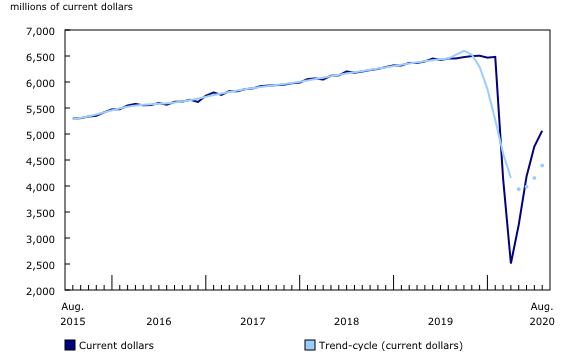Food services and drinking places, August 2020
Archived Content
Information identified as archived is provided for reference, research or recordkeeping purposes. It is not subject to the Government of Canada Web Standards and has not been altered or updated since it was archived. Please "contact us" to request a format other than those available.
Released: 2020-10-22
$5.1 billion
August 2020
6.4% 
(monthly change)
$60.4 million
August 2020
3.9% 
(monthly change)
$19.7 million
August 2020
5.8% 
(monthly change)
$116.5 million
August 2020
2.3% 
(monthly change)
$91.6 million
August 2020
3.6% 
(monthly change)
$1,021.0 million
August 2020
6.5% 
(monthly change)
$1,882.4 million
August 2020
9.5% 
(monthly change)
$152.5 million
August 2020
-3.7% 
(monthly change)
$147.2 million
August 2020
2.2% 
(monthly change)
$684.5 million
August 2020
5.5% 
(monthly change)
$873.3 million
August 2020
4.1% 
(monthly change)
$5.9 million
August 2020
5.3% 
(monthly change)
$5.7 million
August 2020
6.9% 
(monthly change)
$1.6 million
August 2020
0.3% 
(monthly change)
Sales in the food services and drinking places subsector increased 6.4% in August. Receipts at full-service restaurants rose 10.4% as dining rooms and patios kept restaurant sales growing during the summer months. Sales at limited-service restaurants increased by 3.4%, while sales at drinking places grew 14.4%, as bars, pubs and some nightclubs continued to reopen. Sales of special food services were relatively unchanged (+0.1%).
Nine provinces reported an increase in sales in August. Ontario (+9.5%) and Quebec (+6.5%) reported the largest increases in dollar and percentage terms. Manitoba (-3.7%) saw the sole decrease.
Further information can be found in the "Food Services and Drinking Places Sales" dashboard. This web application provides access to data on sales in food services and drinking places for Canada, and by province and territory. This dynamic application allows users to compare provincial and territorial data through interactive maps and charts.
Year-over-year sales in the food services and drinking places subsector still down
The figures in this section are based on unadjusted (that is, not seasonally adjusted) estimates.
Due to the effects of COVID-19 on the food services and drinking places subsector, unadjusted sales for August were down by almost one-quarter (-22.1%) compared with August 2019. Sales fell in each of the following industry groups: full-service restaurants (-27.9%), special food services (-57.5%), limited-service restaurants (-8.9%) and drinking places (-36.7%).
Year-over-year sales decreased in every province, with Ontario (-27.0%), Quebec (-19.1%) and British Columbia (-20.5%) reporting the largest declines in dollar terms.
Prices for food purchased from restaurants were up 2.1% in August compared with August 2019 and prices for alcoholic beverages served in licensed establishments were up 1.2% in the same period.
Note to readers
With the release of the August 2020 data, collection is now performed on only selected chains while sales for the other units of the population are estimated from the Goods and Services Tax (GST) administrative data file received from the Canada Revenue Agency. The same approach has also been used retroactively to replace the estimates of reference period January 2016 to date. For consistency in methods throughout the series a linking exercise was done to revise estimates before January 2016. Consequently, both unadjusted and seasonally adjusted monthly data were revised back to January 1998.
All data in this release are seasonally adjusted and are expressed in current dollars, unless otherwise noted. Seasonally adjusted data are data that have been modified to eliminate the effect of seasonal and calendar influences to allow for more meaningful comparisons of economic conditions from period to period. For more information on seasonal adjustment, see Seasonally adjusted data – Frequently asked questions.
Trend-cycle data are included in selected charts as a complement to the seasonally adjusted series. These data represent a smoothed version of the seasonally adjusted time series and provide information on longer-term movements, including changes in direction underlying the series. For information on trend-cycle data, see the StatCan Blog and Trend-cycle estimates – Frequently asked questions.
Data for the current reference month are preliminary. Usually, unadjusted data are revised for the previous two months, and seasonally adjusted data are revised for the previous three months. Both seasonally adjusted data and trend-cycle estimates are subject to revision as additional observations become available. These revisions could be large and could even lead to a reversal of movement, especially for reference months near the end of the series or during periods of economic disruption.
Contact information
For more information, or to enquire about the concepts, methods or data quality of this release, contact us (toll-free 1-800-263-1136; 514-283-8300; STATCAN.infostats-infostats.STATCAN@canada.ca) or Media Relations (613-951-4636; STATCAN.mediahotline-ligneinfomedias.STATCAN@canada.ca).
- Date modified:


